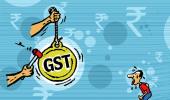Lamborghini has sold 10,112 cars worldwide -- so India's 100 is certainly a big deal for them.
But how big a deal is it for us to peg our consumption theories around, asks Rama Bijapurkar.

India's consumption pattern is confusing if you search for a singular thread instead of embracing multiple narratives (is there any other way to make sense of India?).
More so, if you don't internalise the fundamental structure of its consumption -- large in aggregate terms but made up of numerous modest income earners and spenders.
Or if you forget that a small percentage of India's large population is larger than a big percentage of the small population of other markets.
This is why India can easily rank as both the second or third-largest market for high-end luxury brands or cars, while having a modest income consumer base.
There are three discourses about our consumption story that are running parallelly at this moment in business and the media.
One revolves around Lamborghinis selling like hot cakes and a long waiting list for high-end SUVs, thus demonstrating that "people have so much money".
The second is around disappointing quarterly results showing "the K shaped divide" in consumption, the evaporating mass market and rural market consumption and how 'premiumisation' is the new success strategy.
The third discourse is around data from the new Household Consumption Expenditure Survey (HCES), which some say shows exaggerated improvement in the past 10 years, while others are appalled by how small the numbers are.
Yet others are celebrating the evolution of the consumption story given the sharp decline in share of food in expenditure.

Let's start with the "so what" of HCES for business.
Yet again, there is evidence of modest incomes -- the highest spending 5 per cent of urban Indians come from households that spend Rs 11,24,000 a year (taking a family size of 4.5, though rich urban families have a smaller family size).
At the risk of upsetting purists, let us increase this by a factor of 2.2, which is the difference between per capita private final consumption expenditure (PFCE) numbers put out by the government and annualised PCE from the Survey.
That is still a small spend by a small number of people.
Also evident is the presence of similar income populations in urban and rural India, as seen in past income surveys.
Marketers have, for long, noticed the blurring urban-rural divide as the media, goods, roads and "census towns" have started connecting the two mentally and physically, creating expanding "peri / semi urban" or "rurban" consumers.
The HCES shows that while the bottom 10 per cent of rural India and the top 5 per cent of urban India are outliers, the remaining have overlapping incomes.
Large mass markets with modest-income consumers are finally emerging (see table).
In the table, enthusiasts for defining the "middle class" are free to locate the middle class anywhere they think appropriate.
What does not change is the modest expenditure levels vis-a-vis most other markets.
While we await data on household characteristics by monthly per capita consumption expenditure (MPCE) class, using Kantar data the 4 million urban and 0.4 million rural households having car, air conditioners and laptops/PC probably fall into L5, and the 114 million households, equally divided between urban and rural areas, with a refrigerator, two-wheeler, and colour TV mostly belong to L2.
Also interesting is that in the richer band of L4, there are almost double the number of rural consumers than urban.
L3, the bridge class of 100 million urban people, is likely what a lot of marketers empirically observe and create the "mild premium" segment for (and incorrectly bet large on it).
Now to put some perspective into the Lamborghini discourse: A little over 100 Lamborghinis have been sold in a year in India.
The equivalent number for Maruti Swift is over 200,000 and for all cars is 4.1 million.
Lamborghini has sold 10,112 cars worldwide -- so India's 100 is certainly a big deal for them.
But how big a deal is it for us to peg our consumption theories around?
Secondly, even the 4.1 million new cars sold in this country are mostly bought by the richest 10 per cent of households with some spillover into the next 10 per cent.
Finally, let's address the ongoing discussion on why mass market consumption has done badly.
The answer is obvious if one is truthful about occupation realities in India (skills, education, predictable jobs versus own account workers) and the higher impact of Covid on some.
Anecdotally, we repeatedly hear about school fees and rents that had to be paid despite incomes crashing, of small enterprises shutting down and savings being wiped out (surplus incomes for 60 per cent of India have always been very slim).
Direct benefit transfers, food welfare and innate optimism have injected some resilience but spending choices are being stringently made.
Nearly 200 million in L3, L4, L5 are stable, resilient consumers (perhaps India's real middle class) but only 46 million are in rural India.
L2 is where the strain is felt by mass market marketers as consumers are ruthlessly balancing budgets and making choices across categories.
Companies saying "let's premiumise and ignore the enfeebled mass" are seeking short-sighted safety.
When mass markets start growing again, will they have irrevocably conceded space to the ever-improving band of small local players?
Rama Bijapurkar is a business advisor in the area of customer-based business strategy. Her forthcoming book is titled Lilliput Land: How small is driving India's mega consumption story
Feature Presentation: Aslam Hunani/Rediff.com











